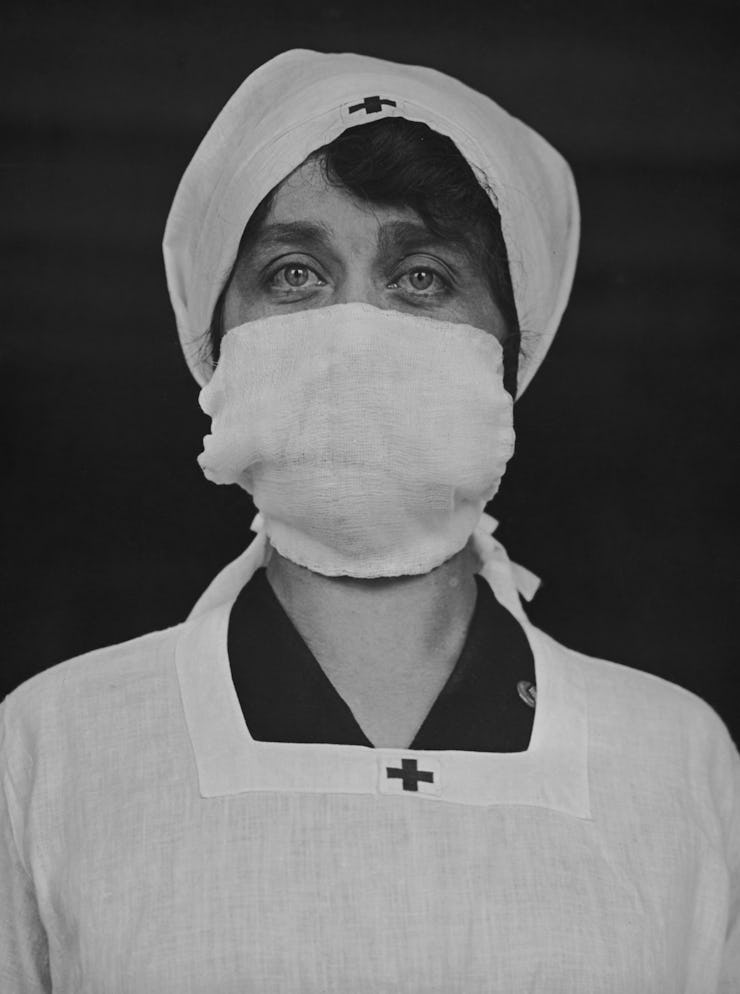Americans are repeating one mistake from 1918
Plus: Scientists discover a new mineral deep inside Earth

If history is any indication, Covid-19 in America, which brought this country to a halt some 620 days ago, will be forgotten much sooner than it should be. It’s tough to forget the loved ones we lost and the politicization of this disease over the last 20 months. It’s also very easy to want to put it behind us forever and move forward.
Historians who have studied the aftermath of the 1918 influenza pandemic say the lessons from that pandemic — maybe even the most crucial — won’t remain in the culture as new standards of public health.
That insight is the subject of our lead story today in Inverse Daily. I’m Nick Lucchesi, an editor here. Thanks for being with us!
This is an adapted version of the Inverse Daily newsletter for Monday, November 22, 2021. Subscribe for free and earn rewards for reading every day in your inbox. ✉️
The use of a facemask by Red Cross personnel in the United States helps decrease the spread of the disease, circa 1918.
We're forgetting one lesson from the 1918 pandemic
[By Katie MacBride]
Not more than a decade after the 1918 influenza pandemic, Victor Vaughan, a physician who lived through it, published A Doctor’s Memories.
About the pandemic he wrote:
“I am not going into the history of the influenza epidemic. It encircled the world, visited the remotest corners, taking toll of the most robust, sparing neither soldier nor civilian, and flaunting its red flag in the face of science.”
Throughout the Covid-19 pandemic, historians and casual observers have turned to the 1918 Spanish Flu pandemic for potential lessons. But before Covid-19, the Spanish flu pandemic was so infrequently discussed that one of the relatively few books on the subject is called America’s Forgotten Pandemic.
Historians say the biggest lesson we can learn from the 1918 pandemic is how quickly people wanted to forget about it.
Related:
Can fasting or the keto diet slow aging?
[By Nick Keppler]
The term “anti-aging” has jumped from moisturizer containers and vials of retinol serum to cookbooks and herbal supplements. For these, “anti-aging” is not only a cosmetic effect — smooth skin, clear eyes — but a nutritional strategy that can actually slow the age-related deterioration of the body and brain by fine-tuning our internal molecular process. Or can it?
When it comes to diets, the “anti-aging” label can be misleading — that’s the conclusion of a new, sweeping review article published last week in the journal Science. The review authors call into question the idea that studies done primarily on rodents and non-mammalian subjects can have any implication for human health.
Related:
Davemaoite mineral in a diamond.
Scientists discover a new mineral deep inside Earth
[By Sarah Wells]
When Oliver Tschauner and colleagues dusted off a sample of volcano-ejected diamond found in a South African mine, they had no idea that they were holding the first-ever natural sample of a new high-pressure mineral from deep within Earth.
While minuscule, researchers predict that this mineral is responsible for moving crucial components like rare earth metals and radioactive isotopes through the Earth’s mantle. To figure this out, the team turned to X-ray beams and lasers.
Tschauner is a research professor of mineralogy at the University of Nevada, Las Vegas, and the first author of a new paper published in Science earlier this month that describes the discovery. He tells Inverse that this discovery was decades in the making — and simultaneously stumbled into at the last minute.
“We were actually not really looking for [davemaoite],” Tschauner says. “We had no suspicion that it occurs in this diamond.”
Related:
Alpha Centauri, the closest star system to the Sun at left and aka Rigel Kentaurus and Beta Centauri at right, aka Hadar in Centaurus, and together known as the Pointer Stars.
A new telescope may find a livable planet near Alpha Centauri
[By Passant Rabie]
Is there life beyond Earth? Across galaxies and billions of star systems, the possibility for life on other planets is endless. But it sure would be convenient if life was located right next door, cosmically speaking.
A newly announced mission aims to explore the closest star system, Alpha Centauri, to find whether or not the neighboring stars have orbiting planets around them and if those planets may be habitable.
The new mission is a privately funded telescope dubbed TOLIMAN, the original Arabic name for Alpha Centauri. TOLIMAN also stands for Telescope for Orbit Locus Interferometric Monitoring of our Astronomical Neighbourhood. It is set to launch in the mid-2020s.
Related:
Jamie Lee Curtis on the set of Halloween, which was released in 1978. She most recently appeared in Halloween Kills, the latest entrant in the long-running franchise. Curtis marks a birthday today.
- About the newsletter: Do you think it can be improved? Have a story idea? Want to share a story about the time you met an astronaut? Send those thoughts and more to newsletter@inverse.com.
- Notable birthdays: Hailey Bieber (25), Mark Ruffalo (54), Jamie Lee Curtis (63), Michael K. Williams (1966-2021).
- Song of the Day: “History Repeats” by Brittany Howard